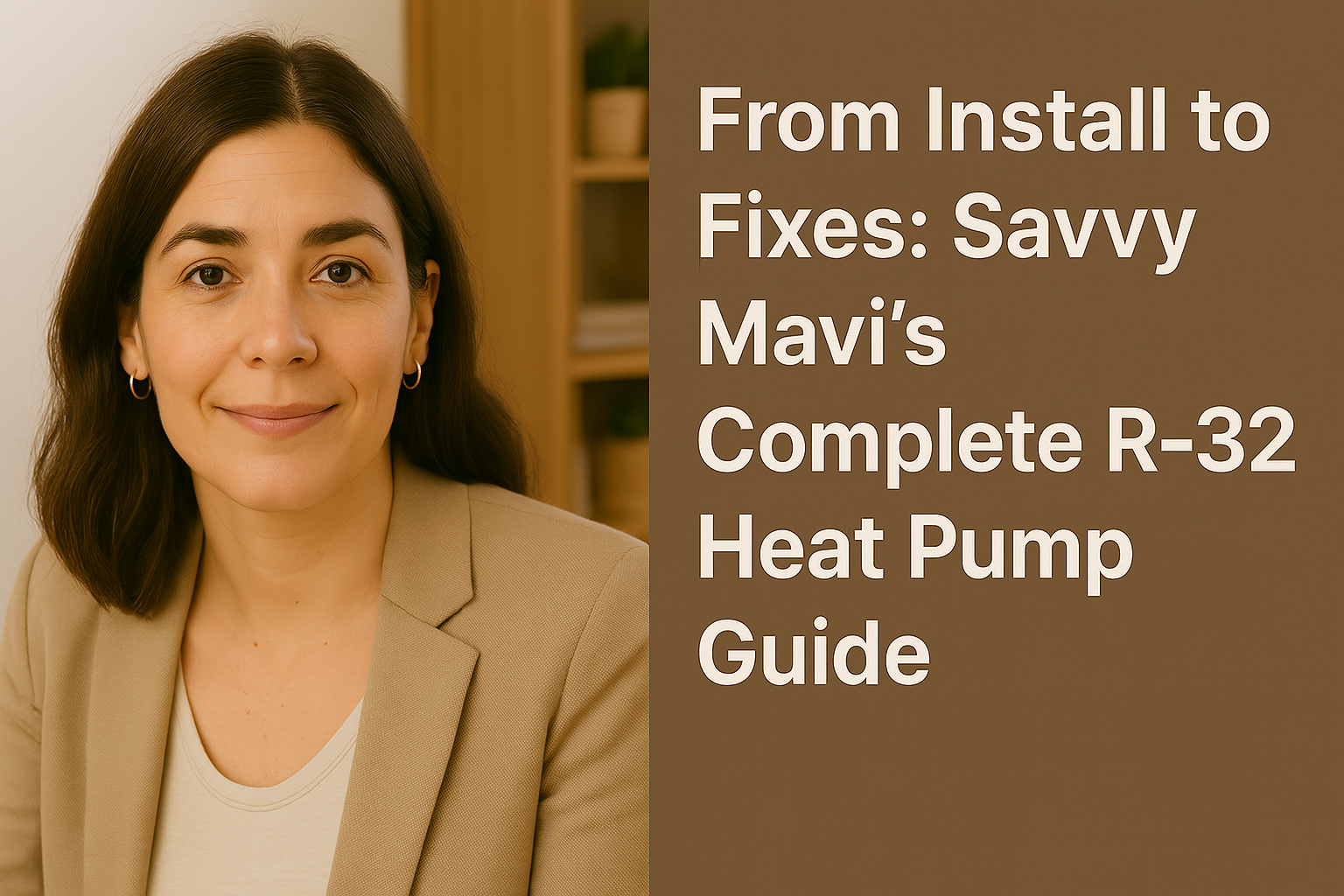👋 Intro from Savvy Mavi
Hey hey, homeowners and HVAC heroes — it’s your favorite home-energy BFF, Savvy Mavi, back at it with another super-practical, super-sassy guide! 🌟 Whether you’re upgrading your HVAC setup for the first time or you’re a seasoned DIYer looking to tackle an R‑32 heat pump installation, you’ve come to the right place.
When I first heard about R‑32 refrigerant, I was instantly sold — we’re talking a smarter, greener refrigerant that keeps your house comfy and your energy bills lighter. Installing and maintaining one of these sleek systems doesn’t have to feel like rocket science. From choosing the perfect spot for your unit to diagnosing those pesky performance hiccups, I’ll take you by the hand and show you the ropes — all in my signature friendly style.
And here’s the best part: you don’t have to figure it out alone. Keep reading for my foolproof prep list, clear-as-day install instructions, quick-fix troubleshooting chart, and maintenance hacks that will keep your system humming for years. Ready to become a heat pump hero? Let’s jump in! 🔥❄️
1. Why R‑32 Rocks the Cool World 🌿
1.1 Eco-Friendly GWP
R‑32’s Global Warming Potential is ~675—way lower than R‑410A’s ~2,088. Compare side‑by‑side in this refrigerant GWP chart.
1.2 Top-Tier Efficiency
Daikin notes R‑32 systems deliver around 10–12% more efficiency than older refrigerants. Peek at their R‑32 energy efficiency report.
1.3 Regulation-Friendly
R‑32 is fully EPA SNAP‑approved and compliant with the AIM Act—future-proof your install.
1.4 Single Compound, No Hassle
It’s not a blend—so charging, recovery, and recycling are clean and consistent.
1.5 Slightly Flammable (A2L Category)
Yes, R‑32 is A2L-rated. But with certified handling, it's perfectly safe—check ASHRAE’s R‑32 safety overview.
2. Pre‑Install Prep: Do It Smart 🧰
✅ Hire a Certified Pro
Only someone with EPA Section 608 certification can lawfully handle R‑32. Learn more in this EPA certification guide.
✅ Choose the Right Spot
-
Outdoor unit should be level with at least 24" clearance around it.
-
Indoor handler needs 30" clearance and ducting around 350 CFM/ton.
✅ Electrical Essentials
-
Dedicated 208/230 V circuit with fused disconnect
-
Proper gauge wiring by unit specs
-
Secure thermostat wiring
✅ Refrigerant Lines Setup
-
Purge with nitrogen and pressure-test
-
Evacuate to <500 microns
-
Leave valves accessible for service
3. Installation: Step by Savvy Mavi 🔩
-
Inspect components: Unit, lines, insulation—no dings or rips
-
Mount the unit: Level pad, anti‑vibe feet, snap photos
-
Pressure test: Purge nitrogen, pressurize, NO drops allowed
-
Evacuate & charge: Reach <500 microns vacuum, charge by subcooling/superheat
-
Electrical work: Wire per schematic, torque terminals, seal well
-
Commissioning: Run heat/cool cycles, record ΔT and subcooling
4. Troubleshooting: Savvy Quick Fixes 🛠
| Issue | Cause | Savvy Fix |
|---|---|---|
| ❌ No power/start‑up fail | Tripped breaker, switch off | Reset breaker, flip switch, check thermostat |
| ❄️ Poor heating/cooling | Blocked filter or coil, low charge | Replace filter, clean coils, measure charge |
| 🧊 Ice on outdoor coil | Defrost failure, sensor, low charge | Defrost, clean coil, inspect sensor |
| 💧 Indoor leaks | Clogged drain/pan crack | Vinegar flush, inspect drain |
| 🔊 Rattling or humming | Loose blades or mount | Tighten blades, level unit |
Catch issues fast—avoid callbacks.
5. Maintenance = Better Efficiency & Life 💵
-
Monthly: Change filters, clear outdoor debris, check thermostat
-
Seasonal (Spring/Fall): Clean coils, straighten fins, flush condensate—Energy.gov’s maintenance guide nails this
-
Annual Pro Check: Refrigerant, fans, blower, defrost cycle, electrical—log everything for warranty
DOE research shows clean coils can boost efficiency by up to 30%.
6. Safety & Certification: No Slacking 🛡
-
EPA Section 608 is mandatory for refrigerant handling
-
Leak rules: Leaks over 50 lbs must be fixed within 30 days, with documentation
-
Cylinder rules: Must be properly marked, charge‑rated, upright
7. DIY vs Pro: Play It Safe
✅ DIY-friendly: Site prep, filter swaps, coil cleaning, visual checks
🚫 Pro-only: Vacuum draw-down, charging, brazing, electrical wiring
Skipping vacuum or charge accuracy = callbacks—and we don’t want that.
8. Warranty & Documentation: Cover Your Bases 📸
-
Photograph before/after installation
-
Log charge, pressure, ΔT, temperatures
-
Keep receipts, certification proofs
-
Stay connected to your installer—they’ll back your warranty claims
9. Bonus Tips from Savvy Mavi 💃
-
Smart thermostat adds precision and energy tracking—worth it!
-
Use heat pump to support your water heater—efficiency bonus 💡
-
Check utility rebates or tax credits for R‑32 systems
-
Address small issues fast—don’t let them grow into big problems
🏁 Outro from Savvy Mavi
And there you have it — you’re officially equipped with all the tools, tips, and tech tricks you need to make your R‑32 heat pump install and care a breeze! 🧰💙 Whether you just installed your system or you’re diving into seasonal maintenance, don’t forget that a little prep and regular TLC go a long way toward long-term savings and worry-free comfort.
If you ever hit a snag or need a pro’s touch, you can always lean on a trusted HVAC tech — and keep this blog handy for quick refreshers. And hey, if you’d like to shop for a top-rated R‑32 heat pump system that fits your home like a glove, take a peek at the full lineup of R-32 heat pump systems right here. They’ve got all the sizes and styles you need to take your setup to the next level.
Need to figure out what size heat pump system is right for you? Visit my guide: Sizing an R‑32 Heat Pump for Your Home — BTUs, Tons & Efficiency Explained.
Thanks for hanging with me — until next time, stay comfortable, stay green, and most of all, stay Savvy! 🌿💙
- Savvy Mavi, your go-to HVAC girl!







